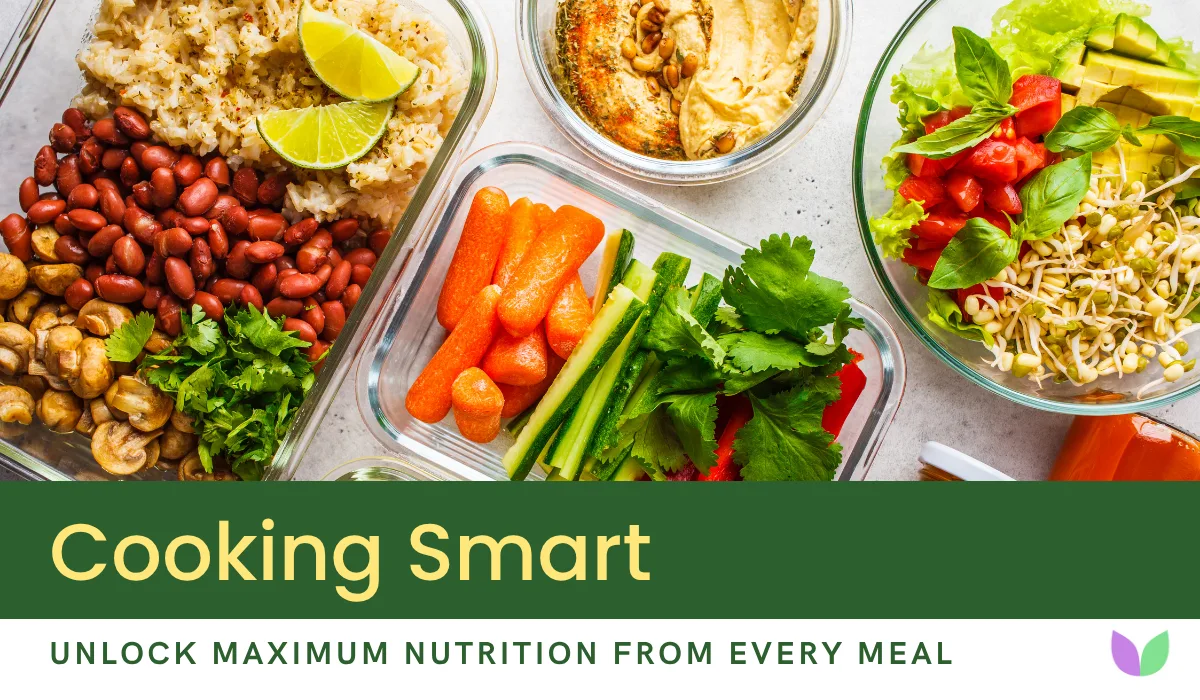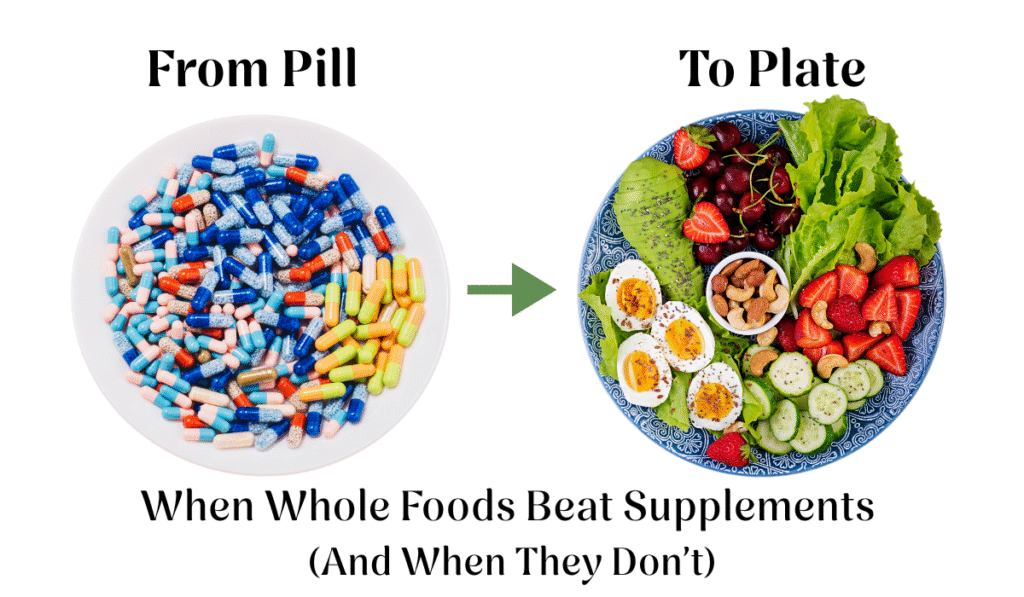When we think about nutrition, most of us focus only on what to eat. However, the way we cook, process, and pair foods can significantly impact how much nutrition the body actually absorbs.
This is because many natural compounds in plant-based foods act as anti-nutrients — they bind minerals like iron, zinc, and calcium, making them less available for absorption. On the other hand, certain cooking and preparation techniques reduce these compounds or enhance the release of beneficial ones.
Here’s a deep dive into some evidence-based cooking strategies to enhance bioavailability and minimize nutrient losses.
1. Soaking, Sprouting, and Fermentation of Legumes & Grains
- Science: Phytic acid inhibits the absorption of iron, zinc, and calcium. Soaking and sprouting activate phytase enzyme, breaking down phytates, while fermentation enhances B-vitamin and mineral bioavailability.
- Tip: Soak dals, sprout moong, or ferment idli batter for maximum benefit.
📖 Reference: Gupta RK et al. “Effect of soaking and germination on phytic acid, total and bioavailable minerals in legumes.” J Food Sci Technol (2015).
2. Pairing Iron with Vitamin C
- Science: Vitamin C converts ferric (Fe³⁺) iron to ferrous (Fe²⁺), the absorbable form, and prevents inhibitory binding with phytates/tannins.
- Tip: Add lemon to dal or sprouts, pair rajma with tomato or capsicum.
📖 Reference: Hallberg L et al. “The role of vitamin C in iron absorption.” Am J Clin Nutr (1989).
3. Cooking Tomatoes and Carrots with Fat
- Science: Lycopene and beta-carotene are fat-soluble antioxidants. Cooking breaks cell walls, and dietary fat improves absorption.
- Tip: Cook tomato-based gravies in oil, sauté carrots with ghee.
📖 Reference: Gartner C et al. “Lycopene is more bioavailable from tomato paste than fresh tomatoes.” Am J Clin Nutr (1997).
4. Using Onion and Garlic for Mineral Absorption
- Science: Sulfur compounds in garlic and onion improve iron and zinc absorption by reducing inhibitory interactions.
- Tip: Add onion-garlic to legume dishes or leafy greens.
📖 Reference: Gautam S et al. “Influence of garlic and onion on bioavailability of iron and zinc from cereals and pulses.” Plant Foods Hum Nutr (2010).
5. Steaming vs Boiling Vegetables
- Science: Boiling leaches water-soluble vitamins like vitamin C and folate; steaming retains more.
- Tip: Prefer steaming; if boiling, reuse the water in soups.
📖 Reference: Miglio C et al. “Effects of different cooking methods on nutritional and physicochemical characteristics of selected vegetables.” J Agric Food Chem (2008).
6. Healthy Fats for Fat-Soluble Vitamins
- Science: Vitamins A, D, E, and K require fat for micelle formation and absorption.
- Tip: Add a teaspoon of ghee or oil to green veggies.
📖 Reference: Brown MJ et al. “Fat intake and absorption of fat-soluble vitamins.” Am J Clin Nutr (1991).
7. Reducing Oxalates in Leafy Vegetables
- Science: Oxalates bind calcium and iron, reducing absorption. Blanching lowers oxalate content.
- Tip: Blanch spinach before cooking; add lemon juice for better absorption.
📖 Reference: Chai W, Liebman M. “Effect of different cooking methods on oxalate content of vegetables.” J Agric Food Chem (2005).
8. Spice Synergy: Turmeric + Black Pepper
- Science: Piperine in black pepper enhances curcumin absorption up to 2000% by inhibiting metabolism.
- Tip: Always add black pepper with turmeric.
📖 Reference: Shoba G et al. “Influence of piperine on the pharmacokinetics of curcumin in animals and human volunteers.” Planta Med (1998).
9. Gentle Roasting of Nuts and Seeds
- Science: Excess heat destroys vitamin E and oxidizes fats. Gentle roasting or soaking reduces tannins and enhances mineral availability.
- Tip: Soak almonds overnight; roast seeds on a low flame.
📖 Reference: Jideani AI et al. “Effect of processing on the nutritional composition and bioavailability of legumes and nuts.” Food Rev Int (2021).
10. Timing Matters
- Science: Polyphenols in tea/coffee inhibit iron absorption; calcium competes with iron for uptake.
- Tip: Keep a 1-hour gap between tea/coffee and meals; separate calcium and iron-rich foods.
📖 Reference: Hurrell RF et al. “Inhibitory and enhancing factors of iron absorption.” Int J Vitam Nutr Res (2010).
Nutrition is not only about “what” you eat but also about how you prepare and combine foods. By using simple yet science-backed strategies, such as soaking, steaming, pairing with vitamin C, and adding the right spices, you can significantly enhance nutrient absorption, making your everyday meals far more beneficial for long-term health.
Summary
Most people focus on what they eat, but how food is cooked, processed, and paired can make a huge difference in nutrient absorption.
This blog explores science-backed cooking techniques that reduce anti-nutrients and enhance bioavailability.
Key strategies include:
- Soaking, sprouting, and fermenting legumes & grains to reduce phytates.
- Pairing iron-rich foods with vitamin C to boost absorption.
- Cooking tomatoes and carrots with fat for better lycopene & beta-carotene uptake.
- Adding onion and garlic to improve iron & zinc absorption.
- Steaming vegetables instead of boiling to retain vitamins.
- Using healthy fats for vitamins A, D, E, and K.
- Blanching leafy greens to reduce oxalates.
- Combining turmeric with black pepper to enhance curcumin absorption.
- Gentle roasting/soaking nuts & seeds to protect nutrients.
- Timing meals and drinks smartly (avoid tea/coffee with meals; separate calcium & iron).
By applying these simple tweaks, everyday meals become more nourishing, supporting long-term health and energy.
FAQs
Q1. Why does cooking method matter for nutrition?
Because some cooking methods (like boiling) leach nutrients, while others (like steaming or sautéing with fat) enhance absorption of vitamins and antioxidants.
Q2. How do anti-nutrients affect health?
Anti-nutrients like phytates and oxalates bind minerals (iron, zinc, calcium), making them harder to absorb. Simple techniques like soaking or blanching reduce their impact.
Q3. Which foods should I pair with vitamin C?
Iron-rich foods (dal, sprouts, rajma, leafy greens) should be paired with vitamin C sources like lemon, tomatoes, or capsicum for better absorption.
Q4. Is raw always better than cooked?
Not always. Cooking tomatoes and carrots actually increases the bioavailability of lycopene and beta-carotene.
Q5. Can tea or coffee really reduce nutrient absorption?
Yes. Polyphenols in tea/coffee reduce iron absorption, so keep at least a 1-hour gap after meals.
✨ Ready to turn everyday choices into powerful health upgrades?
Book your free discovery call with Intuiwell and learn how to align nutrition, lifestyle, and habits with your body’s needs.
👉 Let’s personalize your wellness journey today.
📅 Book a Discovery Call



